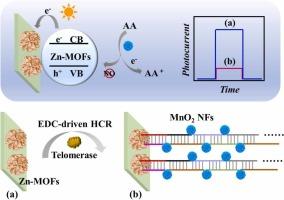An in situ quenching photoelectrochemical biosensor sensitized with dual-amplification DNA circuit for telomerase activity detection in HeLa cells
IF 3.7
1区 化学
Q1 CHEMISTRY, ANALYTICAL
引用次数: 0
Abstract
Abnormal expression of telomerase activity is intimately associated with unrestricted multiplication of tumor cells. As a promising biomarker, precise quantification of telomerase activity provides valuable information for early cancer diagnosis. Here, a novel in situ quenching photoelectrochemical (PEC) biosensor was constructed for the assessment of telomerase activity extracted from HeLa cells. To improve the analytical performance of sensing system, zinc-based metal-organic frameworks (Zn-MOFs) were used as photoelectric active substances and MnO2 nanoflowers (NFs) served as corresponding quenchers which could catalyze ascorbic acid (AA) to form AA+. In situ consumption of electron donor led to the decrease of PEC response. Furthermore, through telomerase activity-dependent intermediate DNA strands triggered entropy-driven catalysis (EDC), the free single-strand DNA fragment was generated on the electrode surface which triggered the subsequent hybridization chain reaction (HCR) and produced the long linear DNA duplexes for loading MnO2 NFs. Notably, this dual-amplification DNA circuit generated tremendously amplified signals. Thus, the method realized telomerase activity assay with a low detection limit of 18 cells/mL HeLa cells and a dynamic range of 50–1×106 cells/mL. Moreover, the biosensor also demonstrated good selectivity and practical utility for detecting telomerase activity in various cell lines. Thus, the strategy held a promising application in telomerase-related field.

双扩增DNA电路致敏的原位猝灭光电化学生物传感器用于HeLa细胞端粒酶活性检测
端粒酶活性的异常表达与肿瘤细胞的无限制增殖密切相关。端粒酶作为一种很有前景的生物标志物,其活性的精确定量为癌症的早期诊断提供了有价值的信息。本研究构建了一种新型的原位猝灭光电化学(PEC)生物传感器,用于评估从HeLa细胞中提取的端粒酶活性。为了提高传感系统的分析性能,采用锌基金属有机骨架(Zn-MOFs)作为光电活性物质,MnO2纳米花(NFs)作为相应的猝灭剂,催化抗坏血酸(AA)生成AA+。电子供体的原位消耗导致PEC响应的降低。此外,通过端粒酶活性依赖的中间DNA链触发熵驱动催化(EDC),在电极表面产生自由的单链DNA片段,引发随后的杂交链反应(HCR),产生用于装载MnO2 NFs的长线性DNA双链。值得注意的是,这种双放大DNA电路产生了极大的放大信号。从而实现端粒酶活性测定,低检出限为18个HeLa细胞/mL,动态范围为50-1×106 cells/mL。此外,该生物传感器在检测各种细胞系端粒酶活性方面也显示出良好的选择性和实用性。因此,该策略在端粒酶相关领域具有广阔的应用前景。
本文章由计算机程序翻译,如有差异,请以英文原文为准。
求助全文
约1分钟内获得全文
求助全文
来源期刊

Sensors and Actuators B: Chemical
工程技术-电化学
CiteScore
14.60
自引率
11.90%
发文量
1776
审稿时长
3.2 months
期刊介绍:
Sensors & Actuators, B: Chemical is an international journal focused on the research and development of chemical transducers. It covers chemical sensors and biosensors, chemical actuators, and analytical microsystems. The journal is interdisciplinary, aiming to publish original works showcasing substantial advancements beyond the current state of the art in these fields, with practical applicability to solving meaningful analytical problems. Review articles are accepted by invitation from an Editor of the journal.
 求助内容:
求助内容: 应助结果提醒方式:
应助结果提醒方式:


